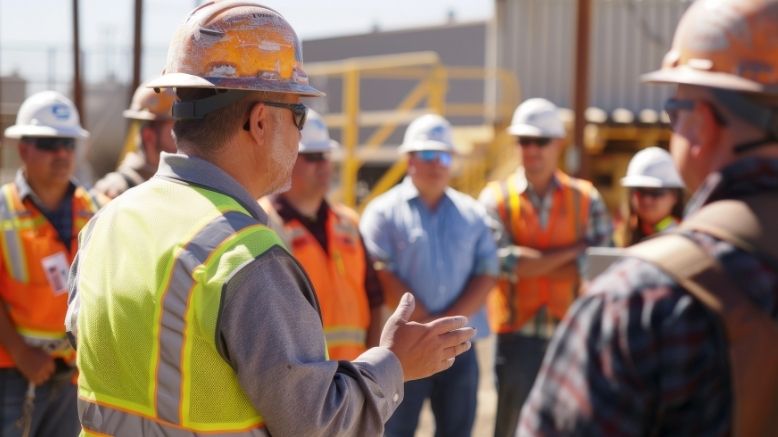— 8 min read
How GCs Can Achieve Better Accountability with Financial Analysis Software


Last Updated Sep 18, 2025

TJ Forbes
Senior Solutions Engineer
19 articles
TJ Forbes is a Senior Solutions Engineer at Procore, specializing in financials products, analytics, ERP integrations, workflows, reporting and accounting solutions. He previously worked as a financial manager and project accountant for Stiles, a commercial real estate firm in Ft. Lauderdale. TJ holds a Masters in Financial Management from Southern Adventist University.

Kacie Goff
Contributing Writer
91 articles
Kacie Goff is a construction writer who grew up in a construction family — her dad owned a concrete company. Over the last decade, she’s blended that experience with her writing expertise to create content for the Construction Progress Coalition, Newsweek, CNET, and others. She founded and runs her own agency, Jot Content, from her home in Ventura, California.
Last Updated Sep 18, 2025

Virtually every general contractor (GC) financially plans for a project before it gets underway. The trouble isn’t necessarily budgeting — it’s monitoring that budget from groundbreak on.
Every project has a multitude of moving parts, all while different people report different information at different times. A GC might not really know how the build shook out compared to its original budget until all of the dust has settled. This robs GCs of valuable opportunities to make informed decisions through the project’s lifecycle.
Without accountability to their budget, they don’t know where or when to spend or save. And that can literally end up costing them, sometimes to the tune of their entire profit margin — or more.
How, then, do contracting firms, which are busy with the actual work of building, see what’s really happening compared to their financial plan? A financial analysis software can do the bulk of the work here, tracking and reconciling actions to the budget as they happen in real-time.
Table of contents
Why GCs Need More Financial Accountability
To underscore why financial accountability is important — and why a software solution might be a big value-add — it helps to understand what currently plagues many GCs in this area.
Lagging Indicators
It’s common for GCs to struggle to see how the project is performing in comparison to the budget in real time.
Take a common scenario as an example: say that the project is running behind schedule. The GC looks at the budget and thinks there’s money to allocate. They bring in additional painters to expedite this late-stage step.
They later learn, though, that the budget wasn’t updated and the extra money actually wasn’t there. That money then needs to come from contingency, if there is any left that late in the project or their profit margin.
Educated Guesswork
Without the ability to analyze the financial standing of the project in real time, the GC’s teams get tasked with making their best guess along the way.
When teams are seasoned, this often goes relatively smoothly because their guesses are, in fact, educated. But as experienced construction professionals near and enter retirement, many firms are operating with greener staff. Without the experience from which to pull, their guesses are less likely to be accurate.
Plus, with so much guesswork involved, the firm might not know if it was a good job or bad job financially until the end of the project.
Missing Layers of Control
When GC companies lack a system for financial analysis, they often don’t have an enforceable way to implement financial controls, too. It’s challenging to track approvals and see who changed what. That can allow high-dollar change orders to get through, affecting the budget in significant ways.
If you don’t have the accountability there, it’s almost like trying to feel around in the dark for a light switch.

TJ Forbes
Senior Solutions Engineer
Procore Technologies
What a Strong Financial Analysis Software Can Do
A good financial analysis software should help GCs see the status of the project’s finances in real time. This directly counteracts the biggest financial accountability challenges, instead delivering the following benefits.
Real-Time Insights
Without software to track the project, the GC needs to rely on reports from different people. The superintendent might report that a project is 75% complete while accounting says that only 30% of the allocated budget has been spent.
With a system in place, the GC’s decision-makers can see who’s actually right (or closer to being right). They gain a way to monitor projects in real time, which then makes it possible to convey accurate information to their own team and external stakeholders like owners and subcontractors.
Proactive Planning
Instead of needing to make educated guesses about a project, a financial analysis software gives teams updated information to hold them accountable and help them plan next steps. It makes it easier to spot deviations from the plan and figure out why they’re happening. If the reason can’t be corrected, it alerts them to find space in the budget elsewhere, helping them avoid overages.
There are a few specific ways this kind of software can help with proactive financial planning.
Comparing Percentage of Completion
Software can compare the percentage of the project completed in both the schedule and the budget — and just as importantly, figure out what’s behind inconsistencies. The sooner gaps are identified, the easier they generally are to fix.
Comparing Against Historical Data
Teams can now track how a project compares against historical data. If the firm knows how much it typically spends per square foot on past projects in the area, it gives them a metric to measure against. If they’re spending more, they can drill down to figure out why.
Monitoring Cash Flow
This is a big reason why GCs go out of business. Even with a million-dollar project underway — all but guaranteeing seven figures in their accounts at a future date — the firm has current bills to pay. To settle up with vendors, subcontractors and their own payroll, they might need to borrow money. In the current environment of high interest rates, the loan could quickly eat into their profits.
Impactful Decision-Making From Higher-Ups
When the GC has a system that keeps all the data where leaders can see it, it sets them up for success (and fewer sleepless nights wondering over what-ifs). When they learn about potential issues early, they have the opportunity to make decisions about them. Informed by the financial data, they can make impactful choices that protect the firm and drive it toward success.
Say the company’s presented with an opportunity to speed up the project. If they don’t know its current financial standing, conservative thinking would encourage their team to say no. If there was room in the budget, though, they could end up having to hand that money back to the owner. Worse yet, if the project goes over schedule, they could face liquidated damages — an extra cost that could have been avoided if they’d had financial analysis software.
The software also supports better planning for future projects. The GC might analyze historical data and see that they consistently have to pull from contingency to cover site labor, for example. Adding more budget for the category on future projects protects the company’s cushion and its profit margin.
The software isn’t only tracking as you go, it’s linking back to the original data which tells you the reasons behind [those choices]. You get a tremendous amount of accountability without having to over-document every single thing.
TJ Forbes
Senior Solutions Engineer
Procore Technologies
Finding and Implementing the Right Solution for Financial Accountability
Getting financial analysis software up and running requires two main steps: finding the right platform and setting it up at the company.
1. Identifying a Solution
The right solution here depends on the GC’s unique needs. Demoing products from different companies should help the firm identify good options. Before deciding, it’s important to loop in the people who will actually be using the tool. They know which features and functions the contracting company truly needs.
Generally, speaking, though, all GCs benefit from adopting a financial analysis software that offers:
- The ability to drill into the data: When a team member sees a number on the page, they need to be able to understand the story behind it. The system has to give them the ability to understand the details to see what really happened on that job.
- The ability to report on information: Capturing data becomes a pointless exercise if the GC can’t review and understand it. The right platform will deliver the ability to turn the data the firm naturally generates on a project into useful information.
2. Implement Financial Analysis Software
To get the financial analysis software to work as intended, the GC needs to integrate it into its tech stack and train team members to properly use it.
Integration
Software integration means that two technologies connect and communicate data between each other. For financial analysis software, the most important integration is with the GC’s accounting system of record. Often called an enterprise resource planning (ERP) tool, this usually captures the bulk of a project’s actual costs. As a result, any financial analysis software needs to be able to pull data from that system into its database.
Other integrations the GC might want to consider include with its:
- Payroll software
- Digital signing platform
- Continuous monitoring tools (e.g., to count people on site)
Training
Deploying new technology is often challenging for GCs, primarily because a lot of construction professionals have a natural resistance to change. Beyond that, the people tasked with learning the tool are usually busy with the work for which they’ve been hired.
To overcome these challenges, it helps to:
- Appoint internal team members to champion the financial analysis tool. Having one or more people tasked with scheduling trainings and monitoring adoption helps to drive change at the ground level. That person can serve as the go-to resource for the software, too, giving people an easy and direct way to get questions answered.
- Establish regular reviews in the system. To require people to input data into the software in a timely manner, have leaders set up regular (e.g., monthly) reviews of the system. Knowing they need to get their information in by a certain date is often all the motivation team members need.
With a financial analysis software set up, GCs replace lagging indicators with real-time insights. They move from educated guesswork to proactive planning. And they implement layers of control, helping their leaders make impactful decisions. All of this results in better financial accountability.
It’s not just about the data, either. The right financial analysis software can give GCs a tool they can use to protect their margin and grow their business.
Was this article helpful?
Thank you for your submission.
0%
0%
You voted that this article was . Was this a mistake? If so, change your vote
Scroll less, learn more about construction.
Subscribe to The Blueprint, Procore’s construction newsletter, to get content from industry experts delivered straight to your inbox.
By clicking this button, you agree to our Privacy Notice and Terms of Service.
Thank you!
You’re signed up to receive The Blueprint newsletter from Procore. You can unsubscribe at any time.
Categories:
Written by

TJ Forbes
Senior Solutions Engineer | Procore Technologies
19 articles
TJ Forbes is a Senior Solutions Engineer at Procore, specializing in financials products, analytics, ERP integrations, workflows, reporting and accounting solutions. He previously worked as a financial manager and project accountant for Stiles, a commercial real estate firm in Ft. Lauderdale. TJ holds a Masters in Financial Management from Southern Adventist University.
View profile
Kacie Goff
Contributing Writer | Procore Technologies
91 articles
Kacie Goff is a construction writer who grew up in a construction family — her dad owned a concrete company. Over the last decade, she’s blended that experience with her writing expertise to create content for the Construction Progress Coalition, Newsweek, CNET, and others. She founded and runs her own agency, Jot Content, from her home in Ventura, California.
View profileExplore more helpful resources

Profit from Predictability: Construction Software as a Business Strategy
For general contractors, managing complex, multi-million-dollar projects, every project phase — from planning and budgeting to on-site execution — is an opportunity to lose time and money. Construction software is...

Defending Against Financial & Legal Risks on Megaprojects
The construction industry has seen marked growth in megaprojects. Some experts classify any project over $500 million as a megaproject, while others argue that the build needs to be $1...

Unlocking Project Intelligence: Moving from Raw Data to Actionable Insights
The construction industry faces a wide range of challenges, from ongoing labor shortages to frequent cost overruns. But some the biggest hurdles all stem from unpredictability. The general contractors (GCs)...

Who is accountable for innovation in construction?
Everyone says construction needs to innovate—but no one agrees on who’s actually responsible for making it happen. Is it the owner? The builders? The tech vendor? Or is innovation everyone’s...
Free Tools
Calculators
Use our calculators to estimate the cost of construction materials for your next project.
Templates
Find a template to help you with your construction project tasks.
Material Price Tracker
Get the latest U.S. retail prices and view historical trends for common building materials.
Glossary
Explore key terms and phrases used in the industry.
